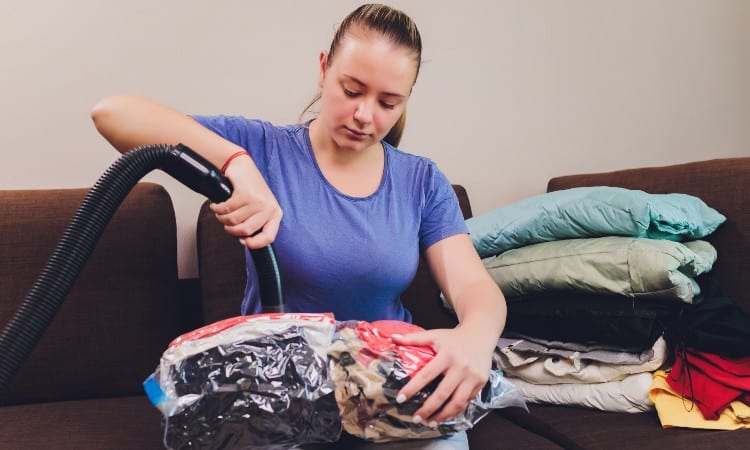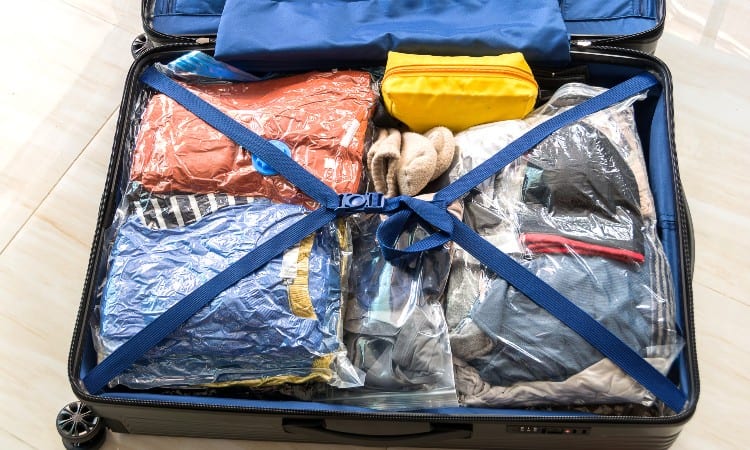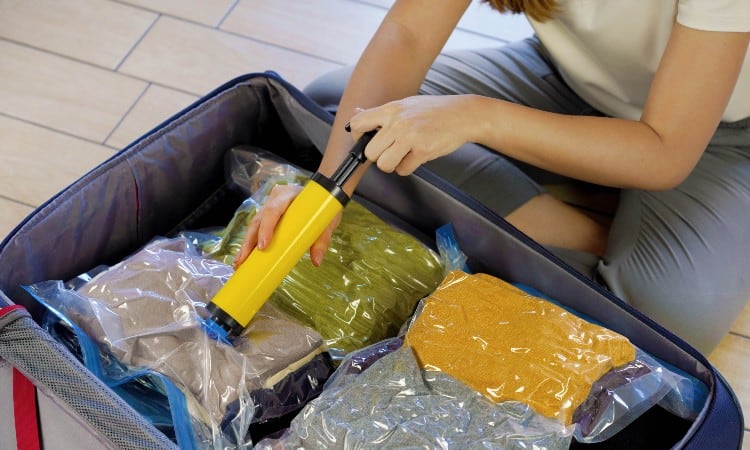Vacuum sealing clothes is a great way to keep elements such as moisture away from clothes in storage. It can also be used to store clothes more compactly, saving valuable space in your closet. But how exactly do you vacuum seal clothes?
There are 3 ways to vacuum seal clothes. The first way is to use vacuum seal bags and your vacuum cleaner to suck the air out of the bags. The second way is to use a garbage bag and your vacuum cleaner. And if you don’t have a vacuum cleaner, you can always roll the bag up to remove as much air as possible.
In this article, I’ll explain how to vacuum seal clothes. But, first, I’ll explain what vacuum sealing is exactly and why you might want to do it to your clothes. Then, we’ll look at all the ways mentioned above for vacuum sealing clothes as well as the advantages and disadvantages of each one.

What Is Vacuum Sealing?
First things first, what is vacuum sealing? The term vacuum means a space that is absent of air. So, vacuum sealing removes all the air from a bag or package before sealing it. Items are sealed inside durable plastic containers, which help to preserve them and prevent damage.
Vacuum sealing is used in food packaging to keep things fresh and increase their shelf life. It can be done in glass jars, plastic bags, or special vacuum-sealing wraps. But you can also vacuum seal clothes to keep them fresh and clean. In the case of clothes, they are usually vacuum sealed inside a plastic bag. Plastic creates a barrier that keeps the elements away from whatever is stored inside the bag. You don’t want to use anything that water could saturate through or that air could pass through when vacuum sealing.
Why Vacuum Seal Clothes?

Now that you know what vacuum sealing is, why might you want to vacuum seal your clothes? There are a couple of reasons. First, vacuum sealing clothes helps protect them from damage so that they last longer. Vacuum sealing removes air from the bag the clothes are kept in and reduces exposure to air. Vacuum sealing clothes also helps to keep water and moisture away from clothes, especially when they are in storage.
The combination of air and water, especially in warm environments, can cause bacteria, mold, and mildew to grow on your clothes. So essentially, vacuum sealing prevents this by reducing exposure to these elements.
Another reason people may vacuum seal clothes is to reduce the storage space the clothes take up. Because air is removed from the bag, it flattens the bag and the clothing and allows it to be stored more compactly.
For example, if you’re packing away your sweaters in the summertime, which are usually pretty bulky, vacuum sealing them makes them less bulky. This makes it easier to store the clothes in boxes or bins, on shelves, or under the bed, especially if you’re short on closet or other storage space.
How to Vacuum Seal Clothes
If you’ve decided to vacuum seal your clothes, there are several ways you can do it. The most convenient way is to buy vacuum seal bags, made of thick and durable plastic that you use with a vacuum cleaner to suck the air out. If you don’t want to buy special bags, you can use a garbage bag instead and use the vacuum to suck the air out that way.
If you don’t have a vacuum, you can still place your clothes in plastic bags, then simply roll them up to remove air. This is the least effective way, but it works great if you’re on a budget or don’t have a vacuum. Now, let’s get into how to use each one of these methods to vacuum seal clothes.
Vacuum Seal Bags

Vacuum seal bags, such as Space Saver bags, can be pricey. But they are the easiest, most convenient, and most effective way to vacuum seal your clothing. And you can use them over and over again.
These bags come in all different sizes and shapes for both large clothing and small items.
They have an attachment for a vacuum hose so you can just attach it and suck all the air out. Here’s how to use them.
Wash the Clothing
Before vacuum sealing clothing, the first thing you want to do is wash and dry the clothing. You don’t want to have stains or anything on the clothes when vacuum sealing them because the stain could set permanently while the clothing is in storage. And since you’re sucking all the air out of the bag, any odors on the clothes will likely still be there when you take the clothing back out.
Remove the stains, then wash the clothing. After washing, make sure the clothing is completely dry before storing it. You also don’t want any moisture in the bag, which can cause damage even when the clothes are vacuum sealed.
Place Clothes Inside
After washing and drying the clothing, place it inside the vacuum seal bags. It’s best to place as many clothing items as possible inside a vacuum seal bag as long as it still closes. That way, you can save the most space and increase the chances of getting all the air out with the vacuum.
Fold each item up and place it inside the bag. For smaller items such as scarves, socks, underwear, etc., you can also roll them up if it’s easier. You may fit even smaller items inside a bag by rolling them up. Then, seal the bag.
Vacuum Out the Air
Now you can begin to vacuum out the air. Most vacuum seal bags work the same way, but read the instructions before you do this just to make sure you’re using them correctly. After reading the instructions, attach your vacuum hose to the opening in the bag. Make sure it forms a tight seal and no air can escape around the hose’s opening.
Then, plug your vacuum in, turn it on, and suck as much air out of the bag as possible. You should see the bag start shrinking around the clothes. When the bag is as small as you can get it, turn the vacuum off and remove the hose from the bag.
When storing the vacuum-sealed bags afterward, you can place them inside a plastic bin, in drawers, or your closet on shelves. Just make sure to store them in a cool, dry, and dark place until you’re ready to wear them again.
Garbage Bags
If you don’t want to buy vacuum seal bags or don’t have the budget for them, you can also use garbage bags and a vacuum. However, make sure that the garbage bags are durable, and you’ll preferably want to use heavy-duty bags so they don’t rip and tear.
The plastic used to make garbage bags may not be as durable as what is used to make vacuum seal bags, so you may be unable to reuse them for more than one season. Also, you won’t be able to make them as compact as you would vacuum seal bags. But one advantage to this is that you can fit many clothes into one garbage bag. Here’s how to do it.
Wash the Clothing
Again, make sure to remove stains, wash, and dry the clothing before putting it inside the garbage bags. You want the clothing to be clean and stain-free if it’s going to be in storage for a while, especially if the bag were to rip and allow air or bacteria into it.
Add the Clothing to the Bag
After washing and drying the clothing, place as much clothing into the bag as you can, but don’t fill it all the way up. You can fold or roll up the clothes to save space. However, you will want to leave enough room to gather the bag at the top and hold it closed to prevent air from getting in while in storage. Don’t use the built-in garbage bag ties to close it because the bag may not close all the way and air can still get in.
Vacuum Out the Air
Insert the vacuum cleaner hose into the opening. Make sure to remove all hose attachments first so that the hose fits better. Small handheld vacuums also work well when vacuum-sealing clothes using a garbage bag.
Next, gather the top of the bag around the vacuum, ensuring no gaps between the vacuum and the bag. You can use your hand to hold the vacuum in place or wrap a rubber band around it. Double-check that there are no gaps in which air can get in. If air can continue to get into the bag while you’re trying to suck all the air out, it won’t be effective.
Then, turn the vacuum on and allow it to suck as much air out as possible. You should see the bag start to shrink around the clothes. If air doesn’t seem to be coming out, double-check that there are no gaps, rips, or tears in the bag that could allow air to come in or escape that way instead.
Seal the Opening
After removing as much air as possible, turn the vacuum off, remove it from the opening, and seal the opening of the bag as soon as you can. Either tie it in a knot or use the rubber band to ensure that the back is tightly closed and no air can escape. This will help preserve the vacuum seal. Just remember not to use the garbage bag ties to close the bag as you normally would. Then, store the bags in a cool, dry, dark place until you’re ready to wear the clothing again.
Rolling Method

This is the least reliable way to vacuum seal clothes, but it can be effective if you don’t have a vacuum. You will need some plastic resealable bags. Ziploc bags work well; they have some jumbo-sized ones just to store clothes and blankets. Then, you’re just going to roll the bag up to remove all the air before sealing it.
Wash the Clothing
Wash and dry the clothing before using this method. This is especially important in this case because it’s highly likely that you’ll be able to get every bit of air out with this method. You don’t want your clothes to have food stains or chemicals that could damage your clothes when exposed to air.
Fold the Clothing Up
For this method, folding the clothing flat will make the bag easier to roll up and take up less space. If you roll the clothing up before putting it in the bag, the bag itself will be harder to roll up. Then, place the clothing in the bag. But note that you may not be able to fit as much into a bag with this method if you want to be able to remove as much air as possible. And again, don’t stuff so much in there that the bag won’t close.
Roll the Bag
After placing the clothing inside, don’t seal the bag. Instead, lay it flat on the ground, then start rolling it up from the bottom to the top of the bag to remove all the air. You can leave the bag flat and use a rolling pin to remove all the air.
Again, with this method, you may not get all of the air out, but you may be able to get most of it. You won’t see the bag shrinking around the clothes like you did with the first two methods. But you should be able to get the bag as flat as possible.
After removing as much air as possible, use one hand or a rolling pin to apply pressure to the top of the bag to keep it closed and prevent air from getting in. Use the other hand to close the seal to keep the air out. That’s why bags that have built-in seals work best for this method. It’s going to be hard to close a bag and keep air out if it already doesn’t have a seal. Finally, store the clothes in a cool, dry, dark area until you need them again.
Does Vacuum Sealing Wrinkle or Damage Clothes?

Remember that one of the purposes of vacuum sealing clothes is to protect the clothes from damage. Vacuum sealing shouldn’t damage clothes provided the clothes were washed beforehand, the vacuum sealing was done correctly, and as much air was removed as possible.
But if the bag or the vacuum seal breaks or the clothes weren’t clean when put into the back, they may come out damaged. This is especially true if they were stored incorrectly or exposed to the elements. That’s why it’s important to store clothes in a cool, dry, dark location, even if they are vacuum sealed.
However, vacuum-sealed clothing may wrinkle in storage, especially if garbage bags or the rolling method was used. Using bags made of thicker plastic can help prevent wrinkling, which is another reason that vacuum seal bags are the best method to use.
Taking Your Clothes Out of Storage
When taking your clothes out of storage after being vacuum sealed, make sure to check for damage, just in case. This can help you know whether the bags you used were effective or if they broke while in storage. After all, accidents can happen and the bags may get caught on something in your closet or elsewhere.
Then, make sure to wash clothing after you take the clothes back out of the bags, especially if you notice any new or fresh stains that weren’t on them before. And if they are wrinkled, washing and drying the clothes can help to remove wrinkles. You can use an iron or steamer to remove wrinkles after the clothes come out of storage.
Conclusion
Vacuum sealing clothes helps to prevent damage and save space while the clothes are in storage. Bags especially made for this purpose are the best way to vacuum seal clothes. But you can also use garbage bags or sealable plastic bags that you can just roll up. Whatever method you choose, I hope you’re successful with vacuum sealing and storing your clothes.